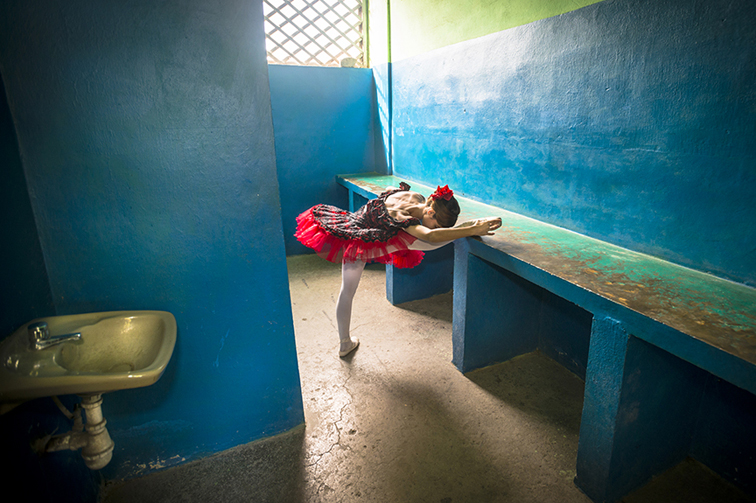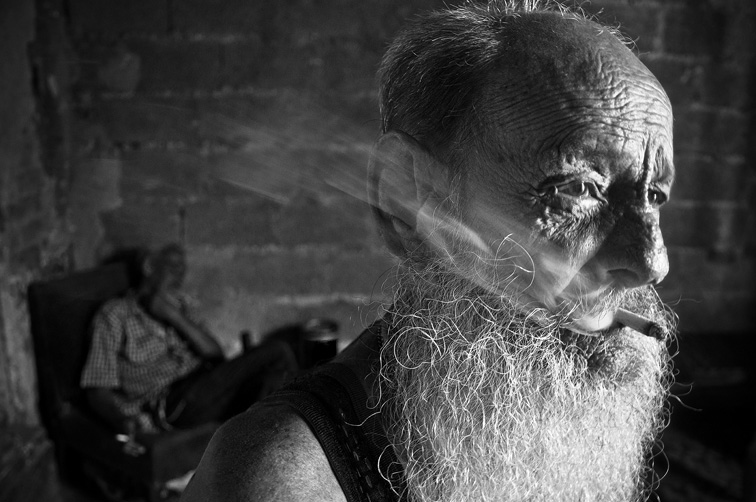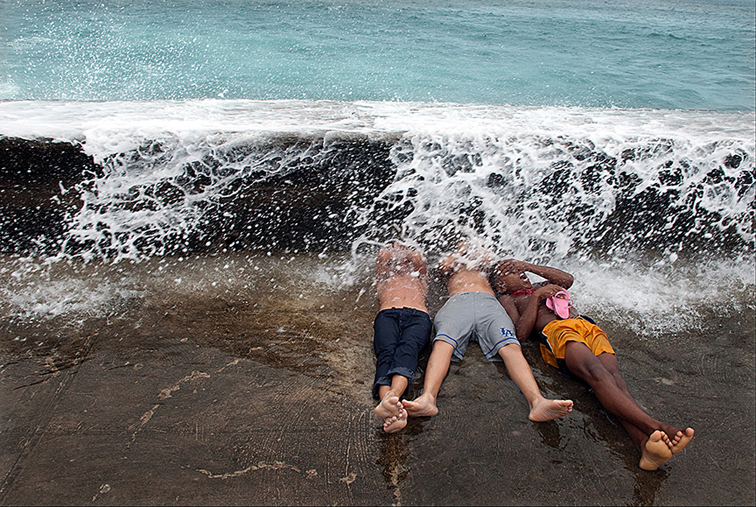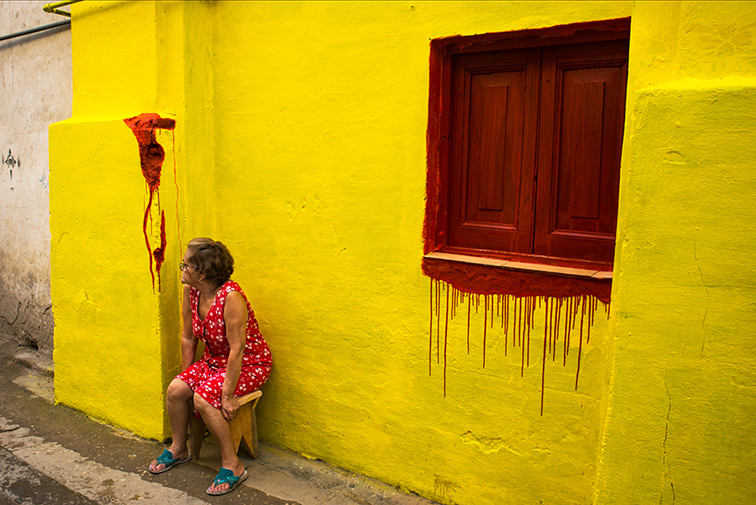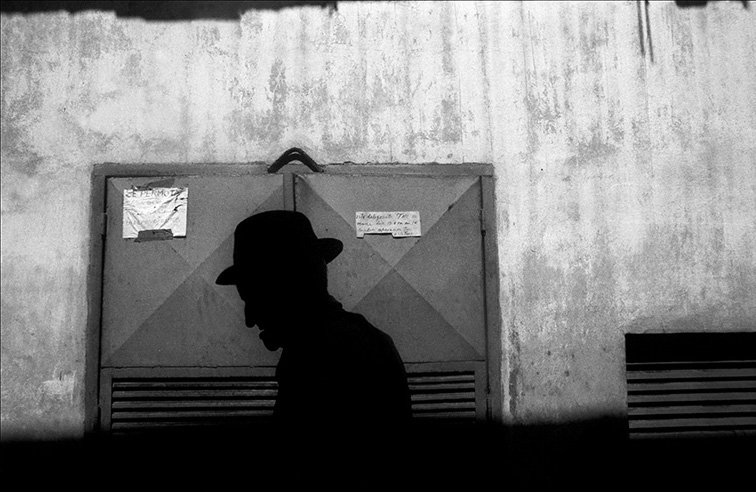I was looking for someone. After my first foray into illustrated interviews, I wanted more. So, my editor Solana Larsen suggested a friend, Arien Chang Castán, a photographer from Havana, Cuba. As soon as I saw his beautiful website filled with old people, seas, solitudes, cities, colours, darknesses, I wrote to him.
The questions in this interview are based entirely on what I observed of his photos and what I read about him on his website. The questions, and answers, were given in an email exchange that took several weeks. I would need more time and closeness to be able to describe and tell the story of Arien Chang, but in the absence of this, below, a photographer in/from Havana.
Global Voices (GV): Tell me the story of your last name.
Arien Chang (AC): My grandfather came to Cuba as an illegal immigrant in 1927. He moved to Old Havana, very close to where I have lived my whole life. He started out in the business of casinos, gaming houses, bars, he even joined a political party that brought together many Chinese immigrants that, like him, had come to Cuba with the hope of new opportunities. Some had even used Cuba as a bridge to cross to the United States (a bridge that we still use…) Of course, working and living in Old Havana, he fell in love with a mulata, who ended up being my grandmother; hence the mix of races and the last name.
Chang is one of the most common family names in China. I had the opportunity to verify this first hand in February, thanks to “Red Gate,” a well-known institution that offers grants to artists from all over the world. For two months I was working on my project, which involved trying to find my roots, the place where my grandfather was born and raised – not because I feel rootless or that I need to find an identity in China, but rather because of the impatience that pursues us and makes us believe that we exist, simply, because we know where we come from.
As a photographer I’m always looking – in my house, in my neighbourhood, in my country – for a new image, a new concept, something that indicates why we exist, where we are going. Photography is my medium and my last name might seem exotic on this island, but that's what is magnificent and photogenic about Cuba: the races, the ages, the history of a whole people are mixed together in its streets. And what’s more, in Cuba we use two family names, the father’s and then the mother’s. My second family name is Castán, which comes from Arabic, and that’s a whole other story of roots and immigrants.
GV: Photographer, why?
AC: I don’t think there is a ‘why’, but I can tell you a bit about how I started, how my life, or rather, how photography changed my life or how my life became photography.
It all started during the hot summer of 2003 (not as hot as it is now), in the América Theatre, a spectacular construction representative of Art Deco, in Galiano Avenue in the centre of Old Havana. They were offering a photography course, along with other unrelated courses like massage and hairdressing, but I just wanted to learn how to use a camera (in those days I didn’t even think about light). It was a very basic course, but in it I finally learned how to use the Russian camera that my father had brought from the Soviet Union, it was a Zenit that had been in a drawer in my house since I was little. I used to play with it and move its controls, it all seemed very fun, of course back then I never imagined that photography would become my life, but I already knew that I liked having a camera around and pushing the shutter.
When I finished the course in the América Theatre, I discovered that I did indeed know how to work the controls but I didn’t know a thing about taking photos. Since I’m a bit stubborn and when I get my mind set on an idea I have to do it, I discovered that the best school for me was on the streets of Havana. Documentary photography is what I wanted to do, what I have done and will continue to do; I’m a photography addict and it’s too late to fix that, now all I can do is surrender myself to this addiction and feed it each day with more work. Photography exists and people can see it, but it must be discovered.
GV: Cuba has been the object of countless photographers. So many that it has developed an image difficult to reinvent. How do you photograph Cuba from the inside?
AC: Photographing Havana from the inside is very easy… you just have to have a Libreta de Abastecimiento (ration booklet) and permanent residence, an ID card or anything that allows you to live here for a while.
The life of a Cuban is not reduced to going to work in the morning and coming home in the evening, people in this country go through an odyssey every day. They are constantly tried by the dynamic of life that we have in this country, to put a name to it. The (non-)transport, the (non-)money, and all the other “nons” that each Cuban faces every day leave marks on their faces, in their clothes, in their spirit, sometimes of desperation, sometimes of fun, but they always reflect a story that if you don’t live it yourself or you don’t know how to read it, you can’t take the photo. We can add to this the incredible architecture, that as we all know is frozen in time and sometimes makes us believe we are in the 40’s. It is this apparent disguise that makes Havana easy and not-so-easy to photograph. This damned Havana is a double-edged sword, which I thank for who I am and what I do.
To create an image you must live it, you must suffer it, and that is why you can sometimes find photos of Cuba that are very well composed, with an impeccable use of colour and light, but at the end of the day they are empty, they are nice little postcards, because the photographer cannot go beyond the impression that Havana makes at first contact.
You have to touch Havana every day, handle it, enjoy it, you have to understand it.
GV: Why take portraits of old people?
AC: For their experience, their tranquility and their wrinkles.
Old people don’t mince their words, they have lived enough to have nothing to lose. In my photos you can see sweet expressions and also looks of hate-disgust at having the lens pointed directly at them. Elderly people, like children, say what they think, they act and get by without fear of the future, because the future for them is already the past.
The series “Longevity”, which I started to develop a few years ago, consists of taking photos of people over 100 years old. A century is a lot of history, even for a country, someone over 100 years old sometimes has less to say with words than with their feelings, expressions.
Old age is intriguing, I don’t expect to live long enough to take my own self portrait and add it to the series; but to photograph someone over a century old is always impressive for me.
GV: Tell me about the sea.
AC: It's impossible to ignore the sea in photography, especially if you live your whole life on an island. Since I was a kid I would escape from school with my friends to go and swim at the Malecón (waterfront esplanade) and like me, generations and generations of Cubans have grown up using this coast-beach, full of reefs, dog-tooth (sharp rocks), as we call it here. Getting to the Malecón, taking off your school uniform and throwing yourself from the highest, most dangerous, deepest part, is less an action than a sense of belonging, a power relationship, you use the sea, sometimes it uses you. Thousands of accidents have happened on Havana’s Malecón, but even so, no-one is afraid of it. The Malecón, or “el Bleco” as we neighbourhood locals affectionately call it, is there and always will be, sometimes calm and sometimes agitated, like the idiosyncrasies of Cubans themselves. It has learned to live with us and us with it, though I hope that the prohibition on swimming at the Malecón doesn’t last.
I miss the sea, when I don’t see it for a few days I miss it, my whole life it has been near me, near my city. The Malecón series, the one that carries the name “el Bleco” in honour of my childhood, is my reconciliation with this city, with this country. It is a debt that I owe it for being Cuban, for being from Havana, for living in it for part of my childhood, my adolescence, for being part of my life.
GV: Black and white or colour?
AC: I don’t think I could choose one, that would be like choosing between two pretty girls, the difference is that I don’t have to choose just one, I can stay with both and be happy.
When I started out in photography my work was all in black and white, analogue and processed in a “laboratory”, that is, the room where I was born on the corner of Monte and Ángeles streets, without any way to close it off, often without water; but with a good enlarger, from the beginning of the 20th century, which allowed me to do my own prints, control my own image from another perspective. There I learned more than anywhere else about lights, shadows, composition and I really enjoyed doing the whole process to my photos.
I spent seven years doing just black and white, even when I made that much-feared change to digital, I still didn’t use colour. It’s only in the last few years that my photos have started having “some” colour. I have always believed that colour is a very difficult technique in documentary photography, the dramatic quality of a black and white photo is always more attractive; but the use of colour when it is necessary, when the image practically cries out for it, has an undeniable strength. But, really, when you see photography you can tell when it is in colour and when it is in black and white. It’s only now that I am trying to understand the language of colour, translate it, I am searching for a personal style; always basing myself on those years that I worked only in black and white, but that helped me begin to understand colour in a different way, I’m trying to reinvent it in these colourful streets of Havana.
I can say that recently I have developed a certain fetish for colour, I really like it a lot and I don’t know… the black and white phase hasn’t ended but I think that in the future colour will predominate my work, that’s my intention.
GV: A bleeding window?
AC: That bleeding window only has one culprit: The Havana Biennial. This kind of big party was happening at that moment, with artists on the streets of Havana, where they intervene in spaces with different art forms, I simply passed by that street, that house. The bleeding window, a coincidence, I saw the image, the dress, the sandals, the contrast of colour with the window, the yellow wall, so I took the photo.
If the window had been another colour or hadn’t been bleeding, or the woman hadn’t been there, maybe I wouldn't have taken a photo or maybe I would have, but of course, it would be a completely different one. I didn’t seek it out, the window came to me and that is what’s incredible about documentary photography, the spontaneity of the moment.
GV: Solitude permeates your photography.
AC: That's an interesting question because no-one has ever spoken to me that way about my photography. I just do photography and that's what I see, maybe it’s the solitude and abandonment of this city that has so many needs, so much history, so many bad memories, and good memories too, but those are secondary.
Solitude, you say, permeates my photography, but being a documentary photographer is a kind of solitude too, it’s a way of being alone, even when you are surrounded by thousands of people, only you know what you capture with your camera that only you can control. What can I say, there are people who are solitary, sad, bitter, just as there are people who are happy, fun, sociable; I simply try to capture their feelings, the stories that they drag around often without realizing that in the way they walk, talk, move around the world, they carry their own load, their own particular solitude.
GV: What is your relationship with the city, Havana?
AC: I really feel as if I were wearing pijamas on the streets of this Havana that has watched me grow and that I am constantly looking at and looking at again and rethinking. I get home, after a whole day of moving around out there, and then, instead of resting, I take my work home because at the end of the day that’s what we photographers are, slaves to our own way of life. I download the photos, I edit, I edit again, I look at them, look at them again, you never know what surprises Havana has in store for you. Sometimes I feel like I violate her, that I am taking advantage of her, that I use her for my own good, but in the end I always thank her with my photos, or at least I try to.
Rediscovering Havana is my main project, my constant aspiration, because sometimes just going out onto her streets is not enough, you have to go into her houses, go up to her roof terraces, talk with her domino players, with the ones who have fighting cocks, with the woman who sells on the corner, and the child who plays ball. In short, my relationship with Havana is very simple: to wake up every day and go out…


